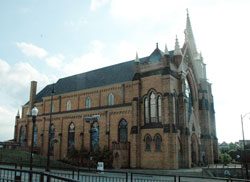Vacation / Travel Supplement
Sacred Pittsburgh: Churches help preserve history of unique Pennsylvania city

St. Mary of the Mount Church, dedicated in 1897, stands atop Mount Washington and can be seen from many points across Pittsburgh. (Photo by Sean Gallagher) Click for a larger version.
By Sean Gallagher
PITTSBURGH—Several beautiful views of Pittsburgh meet the eyes of visitors to Point State Park in the heart of this western Pennsylvania city.
The park sits at the confluence of the Allegheny and Monongahela rivers, and at the start of the Ohio River.
Tour boats often dock there to take sightseers up and down the city’s three rivers.
Across the Allegheny River are Heinz Field and PNC Park, the respective homes of the Pittsburgh Steelers, the city’s National Football League team, and the Pirates, its Major League Baseball club.
And across the Monongahela River, tourists can see Mount Washington rise above the city and its metropolitan region of nearly 2 million people.
As visitors look at the mountain on the south side of Pittsburgh, a large church stands out at the top of it.
It is St. Mary of the Mount Church. The prominence of this church built above Pittsburgh in a sense symbolizes the importance of the Catholic Church in the history of the city.
As the city’s population slowly grew, the Catholic Church grew with it. In the second half of the 19th century, Pittsburgh’s growth took off as the region’s steel and oil industries established bases there.
Prominent landmarks of the Church in Pittsburgh, including St. Mary of the Mount, date to that time period and are well worth a visit for Catholic tourists.
St. Mary of the Mount Parish, the boyhood home of Cardinal Donald W. Wuerl of Washington, was founded at the start of the city’s heyday in the 1870s. Its current church, which features many beautiful stained-glass windows, was dedicated in 1897.
Tourists can visit St. Mary of the Mount Church by riding the historic Duquesne Incline, which opened for service in 1877. This railroad track climbs the eastern face of Mount Washington, and has a total rise of 400 feet on a grade of 30 degrees.
The Incline is open year-round, and has a reasonable fair of $4.50 round trip for adults and $2.20 round trip for children ages 6-11.
Many restaurants offer scenic views of Pittsburgh in the neighborhood around Mount St. Mary Church.
St. Anthony’s Chapel in Pittsburgh is quite different from St. Mary of the Mount Church. It is built on the north side of the city instead of its south side, and is hidden in a residential neighborhood rather than perched atop a mountain.
Its calling card is unique with its claim that it houses more saints’ relics—at more than 4,200—than any other church in the world.
A part of Most Holy Name of Jesus Parish in Pittsburgh, St. Anthony’s Chapel was built on Troy Hill in the 1880s through the initiative and financial support of Father Suitbert Mollinger, a Belgian-born priest who began ministering in western Pennsylvania during the late 1850s.
Father Mollinger traveled to Europe several times between 1868 and 1892, and brought back scores of relics that many Church leaders in Germany, Italy and elsewhere wanted to safeguard in the U.S. for the future. At the time, they were concerned that political leaders might close churches there.
The relics, many of which came with
authentication papers, are from saints who lived throughout the history of the Church. Today, the relics line the walls of St. Anthony’s Chapel in beautiful reliquaries inside walnut display cases.
The chapel is open daily, except for Fridays and holidays, from 1 p.m. until 4 p.m.
Between St. Anthony’s Chapel and St. Mary of the Mount Church stands historic St. Paul Cathedral in the middle of Pittsburgh.
Dedicated in 1906, this massive church marked by its Gothic architecture is nearly 250 feet tall. The cost of construction surpassed $1 million more than a century ago. Inside, visitors will be impressed by its ornate marble main altar and side altars as well as the beautiful ribbed ceiling.
In the neighborhood surrounding St. Paul Cathedral are Carnegie-Mellon University and the University of Pittsburgh with its medical center.
Today, approximately 40 percent of the population of the Pittsburgh metropolitan area is Catholic. That percentage has remained about the same in the Diocese of Pittsburgh for many decades.
When visitors to Pittsburgh tour the sacred sites, they also learn much about the life and history of this unique city built along the beautiful mountain range and curving rivers.
(For links to the websites of the churches mentioned in this article, log on to the website of the Diocese of Pittsburgh at www.diopitt.org.) †
